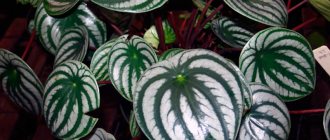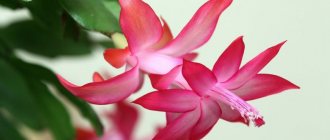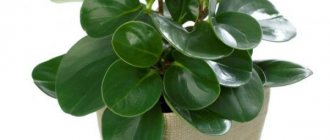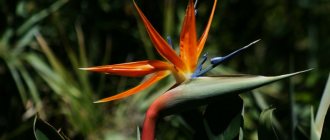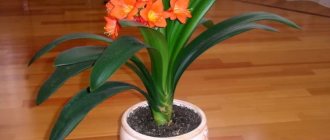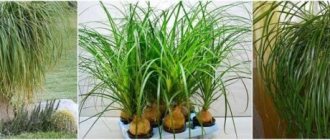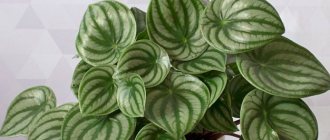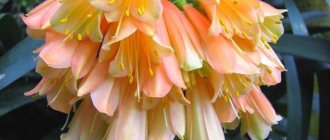Home » Flowers and plants
Vladimir 02.22.2018
10431 View
Peperomia is an evergreen perennial of the Pepper family. Most peperomia are ornamental plants and are used for interior design of residential premises and botanical gardens. Growing peperomia domestica is a fairly simple task and can be done without any difficulties.
External features
In terms of appearance, peperomia comes in several different varieties, ranging from compact and almost dainty to something bolder with thick, colorful leaves. Leaves can come in different colors, shapes and textures.
Even the growth habit can vary, from small compact and rounded varieties to taller upright ones, right up to a number of climbing peperomia. Check out the photo of peperomia and you will fall in love with this plant, and this exquisite indoor flower will delight you with its unusual beauty for many years.
All this variety means that the number of different varieties of peperomia you can buy is huge and incredibly varied, so much so that if you put them side by side you might think you're actually looking at completely different plants!
general information
Peperomia is a pepper plant, and this is easy to understand by its name. It grows in equatorial and tropical latitudes, and it is almost impossible to unite all hundreds of species with a common characteristic. Among them there are shrubs, herbs, succulents, ampelous plants, epiphytes - anything.
Almost all types of peperomia have thick, elastic stems, densely covered with dense, fleshy leaves. The plant stores moisture well, but grows slowly. The shape, shades and sizes are very different from each other. Some varieties are even capable of blooming, but peperomia flowers are not particularly decorative.
Photo: landas.ru
Light
For the most part, indoor peperomia flowers are slow-growing plants that will adapt within reason to the level of light you end up providing. Too much light scorches and washes out the leaves, and too little light will ultimately result in ragged, thin, and unkempt growth.
Peperomias are also one of the few houseplants that tolerate fluorescent light well, so they can be successfully grown permanently in windowless rooms (as long as the indoor light is on most of the day!).
Plant conditions
Soil and container
Considering that the plant is an epiphyte, its roots do not tolerate hard and heavy soil very well. Since the roots of all epiphytes need a lot of air, loose soil is most preferable for them. Thanks to this, the water will quickly reach the roots and will not stagnate.
The plant does not tolerate excess moisture well, so you will need to think about additional drainage of the soil.
Any soil used for succulents or cacti will be suitable for the plant.
If desired, you can also prepare it yourself according to the following scheme:
- leaf soil - 3 parts
- coarse river sand – 1 part
- humus or compost – 1 part
- peat – 1 part
With this ratio in the components, you will get slightly acidic soil, which is ideal for peperomia.
In any case, regardless of the method of obtaining soil, it must be disinfected. It is best to do this in the oven at a temperature of about +100°C.
Then the soil is left in a well-ventilated area without shelter for 10-15 days to restore the microorganisms inhabiting it.
Wrong pot: too low and wide
Pots for plants can be made of any material; the main requirement for them is that there is enough space to accommodate the root system of the plant. The height of the drainage layer for peperomia is from 6 to 8 cm. Accordingly, the height of the pot should be sufficient so that the remaining space is sufficient to accommodate the horse system and substrate.
Lighting
Since the natural conditions for peperomia are the humid, warm climate of the tropics, it is necessary to create precisely these conditions to ensure its normal growth. The plant is located mainly in the lower tiers, so the light reaches it in a diffuse form - this is the kind of lighting that is optimal for it.
Direct sunlight is contraindicated for the plant, so it is best to place it near eastern or western windows
There is no need to use shading or diffusers. If there is a need to place a pot of peperomia on a south window, you can do it that way, however, you should make sure that the light does not fall directly on the plant. For these purposes, you can use some kind of curtains or tulle.
If the plants on the south window are in several rows, peperomia is placed in the second row and so on. The plant requires about 8-10 hours of sun per day. This is fully ensured in the summer, but in winter (more precisely, from October to February) additional lighting will be required.
Peperomia can be grown without sunlight at all, however, it needs about 15-16 hours of artificial light, regardless of the time of year.
Content temperature
Since the plant is native to the tropics, it is thermophilic. Many even consider peperomia to be capricious.
In principle, the conditions in our apartments are quite suitable for Peperomia to be comfortable
The temperature in the warm period should be in the range from +20°C to +22°C, in the cold period from +18°C to +22°C. Plant death occurs at temperatures below +16°C. Such minor changes in temperature in the warm and cold periods are due to the fact that almost all perennial Pepper plants do not have a dormant period as such.
The above temperature limits apply to air, but there are also requirements for the temperature of the substrate. The substrate also has its own range: from +17°C to +20°C. The temperature should be exactly within these limits, no more, no less.
Peperomia in a greenhouse
The metabolism of most tropical plants is such that any changes in “normal” regimes have a detrimental effect on the overall life of the plant and often lead to disease and death.
It is especially important in winter not to overcool the substrate.
To do this, not only should you not place plants in drafts, but also place them on cold window sills. Sometimes wooden or polyurethane stands are used to insulate the plant from the cold base.
Air humidity
It is believed that air humidity is not critical for growing peperomia. However, almost all flower growers are inclined to believe that with more than 50% air humidity, peperomia begins to grow more actively. Perhaps the reason lies in the fact that humidified air is better absorbed by the plant than dry air.
Peperomia will be a great element of your decor
There are also controversial opinions regarding spraying peperomia leaves with a spray bottle. The abundance of hairs can lead to stagnation of moisture in them, and as a result, to leaf rotting or sunburn.
It is recommended to use the following method. Plants that do not have hairs, or those whose hairs are quite sparse, can be sprayed constantly at intervals of 1-2 times a week. Excessively pubescent plants must be sprayed with the same frequency only during the active growing season (from March to May).
In this case, the pot with the plant must be removed from the area where it can get sunburned.
Watering
When studying the question of how to water a flower, be careful, since in this regard it is quite easy to overdo it and create conditions for rotting. You should watch the watering and then wait for the soil to dry out a bit before watering again.
Do not keep the soil constantly wet or allow it to become saturated. At the same time, peperomias are not desert cacti, so be sure to check the situation regularly and provide water when needed. In winter the plant will need very little unless it is particularly warm and bright.
Succulent species
Peperomia dolabriformis
A real succulent with very original leaves. They resemble circles folded in half. There are points at the tips. They are attached to a thick trunk, forming a star-shaped rosette. The leaves reach a length of 7 cm, and a width of about 2 cm. A dark green border is formed at the places where the leaves grow together.
The stems are erect, with few branches, reaching a height of 60 cm. But unlike many relatives, it blooms quite gracefully, producing branched inflorescences with small white-greenish flowers.
Peperomia chisel
Peperomia columella (Peperomia columella) – Column
A very interesting species, striking in the uniqueness of its leaves. Many emerald-colored leaves, similar to dragon scales, densely cover the stem. It grows only 20 cm in height, so it is better to plant the flower in groups. When they reach a certain age, the stems begin to bend in an arched manner, and then they can be planted in pots and used as an hanging plant.
Peperomia columella
Peperomia ferreyrae
A striking representative of epiphytic succulent plants. All the beauty lies in the bright green leaves. They seem to have fused in the middle, and the place of this fusion is highlighted in a darker green color. The height of the plant does not exceed 30 cm, and the leaves can grow up to 7-8 cm in length. Since they contain a large amount of moisture, they are very elastic and thick in appearance. The plant loves moist soil, but does not tolerate stagnant water. Be sure to drain excess water from the pan. If the leaves are heavily dusted, you can make a small tropical rain from the shower with warm water, while being careful not to flood the soil substrate.
Also read: Sedum (Sedum) is a beautiful close relative of the money tree Peperomia Ferreira
Peperomia graveolens
The modest tropical beauty is one of the succulent species of Peperomia. All the beauty is in the leaves of this plant. Nature has colored them quite bizarrely. The leaves are light green above and ruby or burgundy below. The leaves curl in an arc towards the most upright burgundy trunk. The whole appearance of the plant resembles sea coral, especially when the soil is covered with small sea pebbles. It grows as a small bush, up to 25 cm high. It blooms modestly, with long spikelets with light yellow flowers on long burgundy peduncles.
Peperomia graveolens
Peperomia verticillata
A perennial herbaceous plant, evergreen, with ampelous shoots drooping downwards. It has fleshy leaves of a grayish-green color. The whorled form of leaf attachment gives it its corresponding name. This variety is best propagated by cuttings. During the formation of the crown, you can set aside the cut tops for later rooting.
Peperomia whorled
Humidity
Some representatives of this species require fairly high levels of humidity to maintain their original appearance. However, most indoor peperomia plants thrive without any artificial increase in environmental humidity.
Fine leaves can be difficult to clean, so feel free to mist them when they are warm to keep dust away.
Care
Watering
Peperomia can easily survive short-term drought, especially species with thick and fleshy leaves that can store water. Overwatering can be detrimental to the delicate root system of the plant. The watering process should always be kept under control, making sure that the soil does not become sour from frequent flooding. Before the next procedure, the top and middle layers of the soil must dry thoroughly.
Spring and summer watering is more generous than winter. In cold weather, make sure that the soil is almost completely dry before moistening again. Be sure to drain any water that has accumulated in the tray after watering.
Water for irrigation is left for at least 3 days. The temperature should be 2-3 degrees above room temperature. This especially applies to the winter period, when there is a danger of hypothermia of the earthen coma.
For peperomia, acidification of the soil during overflow poses a danger.
Top dressing
Any liquid fertilizer for decorative foliage plants containing a sufficient amount of nitrogen is suitable for feeding peperomia. Fertilizer is applied annually, even in winter, since peperomia does not have a pronounced dormant period. Before use, fertilizers should be diluted 2 times compared to the norm.
- In spring and summer, nutrients are applied once every 2 weeks. Succulent species are fertilized once a month.
- In winter - once a month.
Peperomia is responsive to alternations of organic matter and mineral fertilizers
A positive effect is achieved by alternating organic and mineral fertilizers, which can be purchased at flower shops. Some gardeners also use aquarium water, which contains biologically active substances.
Flowering period
Peperomia blooms most often in spring or summer. Although there are such generous plants that delight their owners with flowers several times a year. The inflorescences are dull and unremarkable, although in some species they are quite original. There is an opinion that it is best to remove flowers so that the plant does not waste energy on them. But this decision remains at the discretion of the owner of the peperomia.
There are rare flowering species, such as Peperomia Rosso. And the Happy Bean peperomia does not bloom at all.
Making this unpretentious plant bloom at home is very simple - you just need to create comfortable conditions for it and a short daylight hours, lasting less than 12 hours.
Peperomia often blooms at home
The pruning or pinching procedure will stimulate more active growth of peperomia throughout the year. In addition, this will give the bush species additional volume and increase their decorative value.
Errors in care and their elimination - table
| Error | Cause | Elimination |
| The leaves turn pale and become limp. | The light is too bright | Shade the plant. |
| Peperomia stops growing, young leaves become smaller. |
|
|
| The leaves begin to wrinkle, dry out and fall off. |
|
|
| Brown dry spots appear on the leaves. | Sunburn |
|
| The plant becomes lethargic, the leaves turn black and fall off. The roots rot. | Overwatering | The plant is watered only when the top layer of soil dries out. |
| The leaves turn yellow and become covered with rusty spots. | Excess fertilizer | Feed the plant correctly, following the fertilizer application rates. |
Pest and disease control - table
| Diseases and pests | Symptoms | Control measures | Prevention |
| Root and root collar rot | The stem rots at ground level and becomes loose and soft. The roots turn black. |
| Do not overwater the plant. Fungal infections often appear due to waterlogged soil. |
| Virus that causes dwarfism | There is a delay in the growth of peperomia, premature flowering and deformation of flowers. | The plant cannot be treated; it is destroyed. | When buying flowers, pay attention to their appearance. Do not purchase diseased flowers. |
| Spider mite | If the air is too dry, a cobweb may appear on the plant, on which a colony of pests settles. Leaves become limp and fall off. | Use fungicidal agents - Fitoverm or Actellik. The spray solution is prepared from 2 ml of the drug and 1 liter of water. The treatment is carried out in the fresh air or indoors with an open window. |
|
| Thrips | High temperature and low humidity cause insects to appear. The reverse side of the leaf becomes covered with a gray-brown coating with a silvery sheen and gradually dies off. |
| |
| Mealybug | Leaves and stems become covered with white, cotton-like lumps of pest secretions. Its activity leads to deformation and falling of leaves. | Soak a cotton swab or napkin in a soap solution and use it to remove insects. |
How to recognize diseases and pests - photo gallery
Mealybugs feed on plant sap Thrips can live both in the ground and on the plant Spider mites are usually located on the underside of the leaf A plant infected with the dwarf virus cannot be treated A plant affected by root rot should be replanted
Temperature
Peperomias strongly dislike cold and drafts, so it may be difficult for them to keep looking nice in winter if you choose a cool location. Make your life easier by placing them in frequently used living areas and away from unheated rooms.
Ideally, at least 15°C and for good growth during the growing season, try to place them in an area where the temperature during the day is 21°C or higher.
Peperomia care at home
The plant loves bright, but indirect light. Variegated forms need brighter lighting than green ones. In summer, the temperature should not rise above 22°C, and in winter it should not fall below 17. Irrigation should be plentiful throughout the year. The coma should not be allowed to dry out even in winter.
The flower tolerates the air humidity inherent in a living room well. It is recommended to spray it only in hot summer time. The leaves are moistened in the morning or evening so that there are no burns on them.
In spring and summer, fertilizing is carried out twice a month. Use any complex fertilizer for beautiful deciduous trees.
Peperomia have no rest period. They can be replanted at any time of the year. Until the age of three, the transplant is done annually. In the future, the land is renewed every 2 years. The soil mixture is made up of peat, sand, and garden soil.
Transfer
Peperomia roots do not grow very quickly, so it usually takes several years to fill the pot and grow out of it. The roots are also quite fragile and delicate, so they can be easily damaged by regular replanting.
You don't need to repot more often than every two to three years, and when you do, just use standard potting compost or a houseplant mix.
Botanical description
The indoor peperomia flower is part of the Pepper family, which consists of evergreen crops with herbaceous or semi-lignified stems. All members of the family live in warm regions. Peperomia are native to the American tropics, where they grow under trees on a thick layer of moss.
Representatives of the peperomia genus never reach large dimensions; the maximum size of a bush is 50 cm in height. They do not stretch like vines, preferring to remain compact, stocky, with dense leaves and small roots.
The modest size of the underground part and the slow growth of shoots make it possible to grow peperomia in the same containers with other plants. No one will feel cramped next to this flower. This property is used when composing living compositions, filling florariums and indoor greenhouses.
The genus Peperomia includes plants with green, brown, red, gray, striped, white and yellow leaves. The plates can be plain, multi-colored, leathery, wrinkled, thin, fleshy.
Photo: Peperomia flowering
Varieties with multi-colored leaves are called peperomia variegata. This group includes any varieties whose plates are covered with spots, stripes or specks.
The stems of peperomia are thick, leafy along the entire length. The leaves are located opposite.
The plants bloom inconspicuously. In spring or early summer, numerous white or brown candles shoot upward. Each is made up of very small flowers. If the inflorescences are not cut off, dark, dense berries will form on them, suitable for sowing.
Peperomia is not only a beautiful flower, but also brings benefits to the home. It purifies the air by releasing phytoncides. The room in which this representative of the pepper family stands has a clean atmosphere, free of bacteria. Species with a distinct spicy odor can relieve headaches.
There are signs and superstitions according to which peperomias promote peace in the home, improve relationships between family members and attract money.
Reproduction
If you want to propagate, cuttings from peperomia plants are usually planted from spring to late summer. If you have a tall erect or hanging peperomia, take stem cuttings. It is simply a piece of stem with a leaf or two attached.
The stem then goes into cutting compost, which you keep moist and warm. After about a month, if all goes well, roots will form and new leaves should appear.
If instead you have a bushy peperomia, then taking stem cuttings is not practical as they are very soft and will simply rot. So, you take leaf cuttings and propagate them just like violets.
Plant propagation
Peperomia is propagated in three ways:
- seeds
- cuttings
- leaves
The seed method of reproduction in peperomia cannot be called simple, but it is not as problematic as in many ornamental plants. Seeds are planted in containers in several furrows, the distance between which is about 8 cm.
The composition of the soil for growing seeds is as follows: one part each of leaf soil and coarse sand.
Peperomia cuttings
After planting, the seeds are watered with warm water and covered with plastic film. The temperature in such a “greenhouse” should be about +25°C. As the shoots appear, they are picked on the second leaf. After most of the seeds have sprouted, the containers are moved to areas with sunlight ; As a rule, at this time they are transplanted into individual peat or plastic pots.
The composition of the soil is the same as that of the seeds. As soon as the young plants are completely strong, they are transplanted into an “adult” substrate. The first pot is usually chosen small - about 5 cm in diameter.
Peperomia ready for potting
Propagation by cuttings is the most popular method of propagating peperomia. It can be produced at any time except during the flowering period. This is done simply: cut a cutting that has one node and plant it in a nutrient mixture.
The mixture can be anything : the same as that of the mother plant or a seed one. Rooting of cuttings usually occurs after 3.5 weeks. In this case, it is advisable to maintain the temperature 1-2°C higher than that required for peperomia.
Deciduous propagation differs little from cuttings; Instead of a cutting, in this case a large leaf is used. It is planted in the substrate in the same way, however, before this the cut is treated with epin.
Growth rate
All types of peperomia are slow-growing houseplants and will take many years to outgrow the location you choose for your plant.
Reviews from flower growers
This little pepper makes me very happy. She is joyful, cheerful. I call it Peperomia magnolia folia “Golden Gate”. But maybe I'm wrong. Young leaves are yellow, really golden. The old ones lose their yellow color and become silver. It has been growing for me for 2 years. As long as she's upright. It grows slowly. I don’t want it to collapse and turn into an ampel. I'll probably have to re-root the tops in the spring.
Milusha
https://forum.bestflowers.ru/t/peperomija-peperomia.1250/page-39
I have a mix of peperomia growing. I want all sorts of different things, but there’s not enough space. Therefore, we have to make a communal apartment. When they outgrow them, I cut off the tops of their heads.
Lena I
https://forum.bestflowers.ru/t/peperomija-peperomia.1250/page-39
This winter I bought three small unrooted cuttings of peperomia coinifolia. At first it grew very slowly, and the color of the leaves was pale, but in May it began to spike very well, side shoots from the main branches began to appear, which also then, if they spread along the ground, took root. I really like her
Dali
https://frauflora.ru/viewtopic.php?f=100&t=8097&sid=1854b41c6c14130153ecafc5fa695fb3
It is believed that peperomia can improve the energy field in the house, making it cleaner and preventing negative emotions from manifesting. In a word, the flower only sets you up for the positive)
Lyntik
https://citykey.net/review/krasavitsa-peperomiya
Thanks to the variety of colors and shapes, peperomia can work a miracle in an apartment. Even if you have very little space for flowers, this plant will help create a comfortable and cozy corner. And its ease of care will make it a welcome guest in any home.
- Author: Irina Morenko
Good day! My name is Irina. I live in a wonderful place - Crimea. By education - a teacher. I really love nature and animals. I have been interested in floriculture for a long time, but I have only just begun to master the wisdom of gardening. My motto is: live forever, learn forever. Rate this article:
- 5
- 4
- 3
- 2
- 1
(8 votes, average: 5 out of 5)
Share with your friends!
Height and span
There are many different types of peperomia that have different growth patterns, for example some are bushy and others are trailing, however it is unusual for a typical peperomia to grow taller than 25cm or wider than 20cm.
As mentioned, this is a houseplant that takes time to grow to its maximum height and spread, so don't expect this to happen quickly, even if the conditions you provide are ideal.
Types of peperomia
Peperomia is a hanging plant, so it is often used to create complex compositions and is highly valued by decorators. There are many decorative species and varieties.
The most popular of them:
| View | Description |
| Shriveled (wrinkled) | A small compact plant (grows up to 10 cm) with velvety heart-shaped leaves. They are wrinkled, with brown veins on both sides. There are varieties with red foliage. One of the most popular varieties is caperata lilian. |
| Watermelon (silver) | A plant with virtually no stems. Fleshy shiny leaves are attached to long cuttings (10-12 cm). The color is green with light stripes, reminiscent of the color of watermelons, for which the flower received its second name. |
| Tupolifolia | The plant is up to 30 cm high, with wide dark green leaves, fleshy, smooth and very dense. Doesn't bloom. The most popular varieties: variegata, alba. They differ from each other in leaf color. |
| Velvety | Grows up to 50 cm. The dark brown trunk is pubescent, most often the leaves are too. The leaf shape is elongated, oval with lighter veins. |
| Round-leaved (monetolifolia, rotundifolia) | Ampelous small-leaved species. Creeping shoots of light brown color are covered with small round leaves of bright green color. This species has no rest period in its cycle. |
| Cluseifolia | Tall upright bush. Feature: bright color of leaves. In the center they are dark green, closer to the edge the color can be red, pink, yellow or purple. |
| Pereskifolia | An ampelous plant with hard, elongated leaves. The leaves are leathery, dark green. |
| Magnolifolia | Named due to the similarity of the leaves to magnolia. Thick pinkish stems reach a height of up to 40 cm. Variegated forms have leaves with a bright yellow edge. |
| Chisel-shaped (dolabriformis) | A low plant (up to half a meter) with unusual fleshy leaves reminiscent of pea pods. The trunk and foliage are bright green. The most popular varieties: Happy Bean, Ferreira, Nivalis. |
| Creeping (Prostrata, creeping, Scandence) | Epiphyte. The leaves are small, round in shape, located on short stalks. The color is dark green with a lighter edge. |
| Headed (glabella) | Ampelous look. Drooping or creeping shoots up to 20 cm long, covered with fleshy round leaves of bright green color. |
| Rosso | Low, compact shrub. Doesn't bloom. The leaves have different colors: the upper part of the leaf blade is green, and the lower part is burgundy. |
| Whorled | Succulent, ampelous type. Drooping shoots with large gray-green leaves. Attaching leaves with a whorl. |
| Gray-haired | In nature it grows on rocky slopes in Brazil. The succulent leaves are covered with small silvery hairs. |
| Graveolens | A low plant with fleshy bright leaves. The underside is burgundy, the upper is green. Succulent. |
| Multicarpal (polybothry, raindrop) | A rare species, the leaves look like water lilies. Bush height from 20 to 50 cm. |
Recently, Peperomia Mix has appeared in flower shops. This is not a variety as such, but a set of miniature varieties planted in one container.
Flowers
Peperomia are low-maintenance houseplants, and if you provide them with basic care, they will bloom quite often for you. This will depend on your type, but they most often bloom in summer and fall.
The flowers are not scented or particularly colorful, instead the flower is described as "fancy" buds with stems that grow vertically a couple of centimeters above the foliage below.
The pink stems tend to have a slight bend, and this, together with the tiny flowers that emerge, gives an appearance reminiscent of a rat's or gerbil's tail. This is indeed very unusual, but at least the appearance of these strange flowers will be proof that you are treating your peperomia well!
How to care for peperomia: summary
- Loves good lighting levels
- Provide a bright place without direct sunlight
- Watering from low to moderate. Since they are prone to rotting due to overwatering, it is best to water them lightly. Watering once a week or less will likely be sufficient for your plant.
- Moderate room temperature. These plants love warmth, so temperatures above 21°C during the day are best.
- Low level of feeding. Feed two to three times a year.
Diseases, problems, pests and treatment
Peperomia is not very sensitive to diseases, but its immunity can be weakened by ignoring care rules. Overwatering and low temperatures are especially dangerous - in this case, the plant will certainly suffer from fungal diseases.
The fact that the plant is sick will be indicated by its appearance. The flower may lose its variegated color, begin to shed its leaves, or become covered with painful spots. In such cases, the conditions of the plant should be changed and treated with fungicides.
Insects love the juicy leaves of peperomia. Under the lower part of the leaf blades you can find thrips, scale insects, mealybugs, spider mites and even roundworms. Therefore, for the purpose of prevention, treatment with a soap solution or infusions of tobacco, onion, and garlic will not harm the plant. But if there is an obvious infection with parasites, the flower must be treated with industrial insecticidal preparations.
Possible problems with the peperomia plant
Leaves have brown tips and edges
This is usually caused by a sudden drop in temperature or exposure to drafts. Remove damaged leaves if they are very unsightly, and remember to keep your peperomia plant away from cold areas.
Leaves fall from the plant
As with most houseplants, some leaf shedding is normal, but if a lot of leaves are coming off the stems in a short period of time, you have a problem.
In most cases, this is caused by the plant being placed in a place that is too cold or due to watering. The cause of the cold should be easily eliminated.
The leaves have withered, there is rot
As mentioned in the previous issue, leaf wilting may be the first sign of underwatering in Peperomia, but if rot is present, it is usually a sign of overwatering combined with cool temperatures.
All you can do is remove any rotting leaves (they should fall off easily with a little pull anyway) and carefully continue watering in the future. If the damage is very severe, see if you can salvage healthy areas for breeding.
Wavy leaves on a plant
Again, this is typical of overwatering, but over a long period. Reduce the amount of watering you provide and allow the soil to dry out over a longer period. Blisters can also be caused by too much sunlight. In any case, if the damage is significant and spoils the appearance of the plant, remove the affected leaves.
Dull blurry pale leaves
This is most likely caused by too much light over a long period - move to a darker area. If you don't feel like this is the problem, it could also be a sign of underfeeding.
Reproduction methods
Seeds
The seeds should be sown in the spring in a moist mixture of sand and leaf soil (1/1). Using film or glass, a mini greenhouse is created, which is placed in a warm but dark place. After the seedlings grow two leaves, they should be picked and transplanted into a similar substrate, but in a larger container, where they can grow at a distance of 3-4 centimeters from one another.
At this stage, the sprouts should be outdoors and in a well-lit place. After the borings take on the appearance of bushes, they can be planted in soil for adult plants and in separate containers.
Stem cuttings
Apical stems 5-10 cm long with several nodes are suitable as cuttings. You can root them in a mixture of humus, sand and peat (under a film) or sprout the roots in a container with water. The rooting process will take about three weeks, after which the seedlings can be safely planted in standard soil.
Leaf
In this case, a healthy leaf with a petiole is used for propagation. A leaf cut with a sterile blade is rooted for several weeks in water or a mixture of sand and peat; sphagnum can also be used for these purposes. Rooting occurs under the film, in a warm, bright place. When the leaf sprouts roots, it can be planted as an independent plant.
Dividing the bush
This method is used for mature, heavily grown plants during transplantation. The bush is divided into several parts with a blade along with the rhizome and each part is planted in its own pot.
Photo of peperomia plant
Photo
Below is Peperomia: types, photos and names:
Rosso
Blanda
Columella
Graveolens
Caperata Lilian
Marmorata Peperomia verticillata
Pereskiaefolia
Serpens
Argyreia Glabella Green gold
Rotundifolia
Watermelon
Velutina
Variegata Caperata Red Luna
Diseases and pests of Peperomia
These woodland plants are fairly disease resistant, but there are a few bacterial and fungal diseases to watch out for.
The most common disease affecting domestic Peperomia is Pythium root rot, which can very quickly cause the death of a previously healthy plant. This is a fungal infection that thrives in constantly moist soil conditions. It is very important to avoid overwatering your Peperomia. You may notice black or swollen spots forming on the plant's stems, but at this stage it is often too late to do anything about it. The first sign of trouble is usually drooping, wilting, or simply unhealthy looking Peperomia.
Aggressive pruning of affected parts of roots and plants, as well as replanting in a new pot and fresh soil mixture is the best hope for saving the plant.
Indoor Peperomia can be affected by fungus gnats, mites and mealybugs.
- Fungus gnats are small midges that can be seen in the soil. The damage is caused by larvae that feed on the roots of the plant. Adults do not damage the flower directly. Reducing the frequency of watering and adding sand to the soil should help get rid of these pests. Alternatively, adding a small amount of cinnamon powder to the top of the soil is a great option.
- Mealybugs can be found as white masses on the undersides of leaves and on roots. Along with mealybugs, mold is also present. Infected Peperomia will be stunted in growth. Treatment should be with insecticidal soap or spray.
- Mites are typically very tiny and can go undetected for long periods of time, often until significant damage has been done to your plant. These insects can create necrotic areas on leaves and cause stunted growth. Control should consist of completely covering the plant with insecticidal soap or spray.
